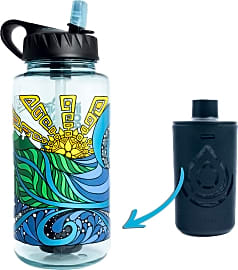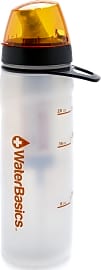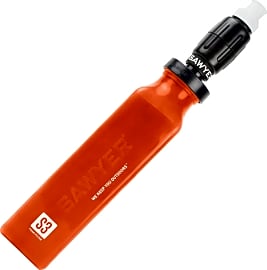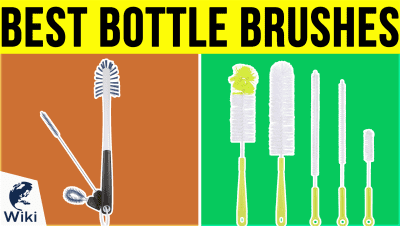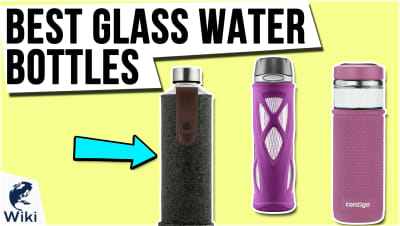The 10 Best Filtered Water Bottles

This wiki has been updated 35 times since it was first published in January of 2017. If you're tired of drinking tap water that leaves a chemical aftertaste, or need a purification method when you're out camping or hiking, try one of these filtered water bottles. They'll remove pollutants, small particles and, in some cases, bacteria and viruses from H2O. As a bonus, they are environmentally friendly, too, saving lots of disposable plastic bottles from going into landfills. When users buy our independently chosen editorial choices, we may earn commissions to help fund the Wiki.
Editor's Notes
December 10, 2020:
If you’re trying to avoid buying plastic, you’ll be glad to see the Brita Stainless join our list. It’s still got some plastic parts in the cap and filter, but the company is making metal bottles in lots of fun colors. The Sawyer Select is pretty new to the market, but its ability to serve as a filtration system that fills other bottles is nice for a group that’s camping together, and it’s light and flexible, a plus for overnight, back-country backpackers who have plenty of other equipment to weigh them down.
Nalgene is a name well-known to many, and they’ve teamed up with Epic Water Filters to create a system with a nice, large capacity. Their filter is made of environmentally-friendly organic coconut shell, and there are a few special edition designs that are attractive. If you’re wondering what the OG in Epic Nalgene OG stands for, it’s--yes, that’s right--'original gangster.’ Naturally.
Remember, your filter will clean your water, but you’ve still got to clean your bottle. Check out the best bottle brushes for a kit to fit your needs.
May 21, 2019:
In this update, we added in the SurviMate 4-stage, which is safe for drawing water from sources like ponds and streams, thanks to its four-filter system. It’s made of food-grade material and is durable enough to withstand being dropped and jostled quite a bit. With the included carabiner, you can easily hang it on your backpack or belt loop. Its built-in compass is an added bonus that will come in handy when you're in the wilderness.
Retaining top spots were the innovative LifeStraw Go, which features an award-winning membrane filter to create clean, safe drinking water; and the compact Grayl Ultralight, which offers a convenient, one-press design that will purify your H2O in seconds. We removed the Bobble Infuse due to concerns regarding its slow flow rate.
Special Honors
Larq Self-Cleaning This stylish, high-tech bottle includes a purification mechanism that you can lift and activate with one hand. You’ll have clean water, free of harmful, odor-causing germs in 60 seconds. Its self-cleaning mode activates every two hours to help ensure it remains smell-free and with fresh-tasting H2O. It’s on the pricey side, but a portion of your purchase is donated to bringing safe drinking water to billions around the world. It’s sold in five cool color combinations like Monaco Blue, Seaside Mint, and Himalayan Pink. livelarq.com
Crazy Cap If you want to add a filtering system to your current water bottle, The Crazy Cap can help. It’s a pocket-size purifying cap that fits onto narrow-necked bottles, and uses UV sterilization to zap your water clean. Can't figure out if it'll fit what you've already got? They sell matching bottles along with the rechargeable caps. thecrazycap.com
A Brief History Of Water Filters
This was likely good for straining out dirt and heavy minerals, but did little for microbes beyond what the boiling accomplished.
The ancient Egyptians were the first known people to try purifying their water. For them, this meant boiling it over fire or leaving it out in the hot sun. The idea was that the heat would kill anything undesirable inside, which turned out to be pretty smart thinking. Of course, they also filtered their water through sand and gravel, so maybe let's hold off on awarding them any Nobel Prizes for science.
Later on, in Greece, the famous physician Hippocrates devised his own method of removing impurities from the water supply. His method involved pouring boiled water through a cloth bag, which he humbly dubbed "The Hippocrates Sleeve." This was likely good for straining out dirt and heavy minerals, but did little for microbes beyond what the boiling accomplished.
Other scientists and tinkerers tried their hand at filtering over the years. Methods included adding herbs, barley, or salt to the drinking supply. As you might expect, these experiments met with little success.
It wasn't until the late 1600s that real progress would start to be made, thanks to the advent of the microscope. Antonie van Leeuwenhoek and Robert Hooke, widely considered to be the fathers of microscopy, were also the first to observe tiny pathogens in bodies of water.
The first widespread attempts to do something about these pathogens wouldn't come until the early 19th century, however, when Scottish bleachery owner John Gibb created the sand filter. This filter uses grains of sand to trap and capture particulates in the water, reducing the amount of toxins inside and improving its taste and odor (not to mention making me look stupid for making fun of the Egyptians a few paragraphs ago).
Water quality standards would be introduced in London in 1852, with the United States following suit some 60 years later. It wouldn't be until 1974, with the passage of the Safe Drinking Water Act, that universal federal standards would be adopted.
Today, most public water supplies are safe to drink, but that doesn't stop people from preferring to do their own filtering. Modern water is pushed through carbon filters, zapped with infrared or ultraviolet radiation, and treated via reverse osmosis, all in the name of improving taste and quality.
Regardless of which filtering method you prefer — or if you just like drinking out of the tap — one thing's for certain: drinking bad water can be hazardous to your health.
The Benefits Of Filtering Your Water
If your local tap water is likely clean and safe, why should you go through the trouble of filtering it? There are a few reasons why people choose to take extra precautions.
One is the taste. If you're not used to it, tap water can taste like it has chlorine in it (this is because it has chlorine in it). Many people don't like feeling as if they're drinking pool water, and a high-quality filter can help even out the flavor.
Try them if you must, but just know that their effectiveness is likely directly correlated to your belief about their effectiveness.
Of course, you could just buy the bottled stuff if you wanted to avoid drinking from the municipal supply, but that can quickly get expensive, not to mention hazardous to the environment. With a filter, you get all the benefits of the store-bought stuff, but at a fraction of the price, and with much less planetary impact.
Some people, especially those with sensitive GI tracts, just feel better when they're drinking the purified stuff. Many filters can help reduce the prevalence of Giardia and other microbes, saving your intestines from having to fight off unwanted invaders.
Beyond that, there are many claims that certain filters can nearly perform miracles, such as ionizing your water or improving the alkalinity of your body. The belief is that, by zapping your liquid with some mystical power, your energy levels, immune system, and overall health will improve.
Do these things work? Probably not — but they may not hurt, either (except in the ol' pocketbook). Try them if you must, but just know that their effectiveness is likely directly correlated to your belief about their effectiveness.
How To Choose The Right Filtered Water Bottle For You
Choosing the right filtered water bottle doesn't have to be a stressful decision. There are only a few key things you need to look for while shopping.
The most important is to decide what your particular needs are. Will you just be using it for the gym, or will you be taking it with you everywhere you go?
If it's just for the gym, you can most likely get away with a smaller model.
If it's just for the gym, you can most likely get away with a smaller model. After all, you'll want something you can stash in your bag, not to mention fit in the cup holders on the elliptical. You should also consider how easy it will be to drink from, especially when you're sucking wind.
However, if this bottle is going to be your new sidekick, look for something a little more generously-sized. Drinking water is good for you, so buy something large and encourage yourself to finish it several times a day. Keep in mind that it will take a little while for the water to matriculate through the filter, so a larger bottle will give you more wiggle room on refills.
Ultimately, the most important thing is to find an option that makes it convenient for you to drink more water. The last thing you want to happen is for you to turn to sodas or sugary fruit juices when you're thirsty, as these can sabotage your diet in the blink of an eye.
Once you find one you like, you can enjoy all of the benefits of a well-hydrated lifestyle, including more energy, a healthier complexion, and most importantly, less time at your desk and more time in the bathroom.







